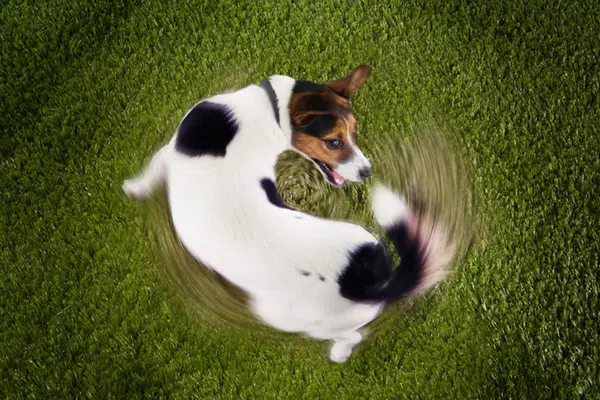
Is there ever a moment when you look at your dog and you wonder, “What the heck is going on in their head?” Some of our dogs’ antics really make us laugh out loud, but they don’t always do them for no reason. When a dog is a dead set on “getting” its own tail, it is engaging in one of these behaviors. While this is certainly amusing to see and enjoyable for your dog, there may be a more serious reason why your dog is chasing its tail.
If you see your dog chasing its tail excessively, or with an obsessive intent, you may have seen an indication of compulsive behavior. If you don’t address your pet’s obsessive tendencies, they may worsen over time, putting their health at risk.
In this article, we’ll go through some of the possible causes of your dog chasing and biting its tail, so you’ll know what to do if and when it occurs.
4 Reasons Your Dog Is Chasing Their Tail
We humans find great amusement in our canine companions’ endless supply of comic antics. To this day, seeing a dog run in tight circles after its own tail remains one of the most iconic (and hilarious) canine routines. There are a number of odd causes that might be making your dog chase its tail, regardless of how cute or odd it may seem.
Activities intended to attract attention
Puppies of all ages enjoy exploring their new environments and discovering their own physical capabilities via play. You can’t help but crack a smile or take a quick snapshot of a little puppy caught in the act of chasing its tail. Puppies, as they mature, become more perceptive to their environment, including your responses to their antics.
One possible explanation for your dog’s incessant tail chasing is the positive reinforcement they get from you whenever they engage in this behavior.
So dogs unconsciously learn to behave in ways that offer them positive rewards like goodies and petting. You may prevent your dog from chasing its tail to get your attention by engaging in another kind of play or distraction with it.
Existence of intestinal parasites
It’s not always a sign of serious health problems, but parasites might be the reason your dog keeps around the house and chasing its tail. Your dog may have tapeworms or another common parasite if you also observe that it is scooting its behind and has diarrhea in addition to chasing its tail.

Being utterly bored
Long periods of alone may make anybody, human or otherwise, antsy. Dogs need a lot of exercises to maintain their optimal mental and physical health. They may begin thinking their tail is fun to play with if they are bored. Dogs may start chasing their tails and running in circles to alleviate their restlessness and satisfy their demand for physical activity. For this reason, it’s important for dog owners to spend more time interacting with their pets, such as by taking their dogs for walks or playing fetch.
Stressed out emotions
When you’re feeling nervous or agitated, how do you usually react? Many of us fidget with things like hair or nail picking. It’s possible that whatever works for us might also help our pets relax. Consider it your own personal method of stress relief. It’s possible that your beloved pet is chasing its tail to relieve stress or worry. Assist your pet in adjusting to a new environment, or if you know you will be gone for a long time and worry that they may get stressed or anxious, by giving them additional attention and reassuring petting and cuddles.
Why Do Dogs Bite Their Tails?
There are times when your dog chews on its tail and it could be totally harmless, but there are times when the tail chewing (or other body parts) can be something to worry about. As it could vary by dog, these are the common reasons why dogs tend to chew on their tails:
- Discomfort. Dogs will chew at the area that is bothering them to get temporary relief.
- Fleas. Fleas are tiny insects that latch onto dogs and cause itchy discomfort.
- Anxiety. Your dog might be licking or chewing its tail if they are experiencing feelings of anxiety.
- Allergies. Like humans, dogs can be allergic to food. Your dog might be chewing their tail to ease any itching sensation caused by an allergic reaction.
How To Identify Compulsive Behaviors in Your Dog
Our four-legged friends are a great company and have certain human traits, as the old adage goes. OCD is not limited to humans; dogs may also be affected (OCD). Though, what the fixation looks like is not a full match to what people feel.
As an example, a dog may gnaw excessively at its tail if it is nervous, or it may spin in circles in anticipation of a reward or upon seeing a familiar face. There are breeds of dogs that are more likely to develop obsessive habits.
Your dog’s anxiousness may have a variety of reasons, but you may narrow it down by observing the circumstances under which the tail chasing begins. Once you know what triggers them, you may take steps to prevent it. Your pet’s obsessive behavior may become more amusing than dangerous if you are able to lessen its occurrence.
When It Gets Tiresome to Keep Chasing Their Tail
Though it might be funny to watch a dog spin in circles attempting to catch its tail, owners should consider the possibility that there is a more serious explanation. There can be times when your dog will chase its own tail; it’s normal, but it’s vital to keep an eye on how frequently this happens. If your dog is still chasing its tail or exhibiting other indications of distress, it may be time to take him to the doctor.